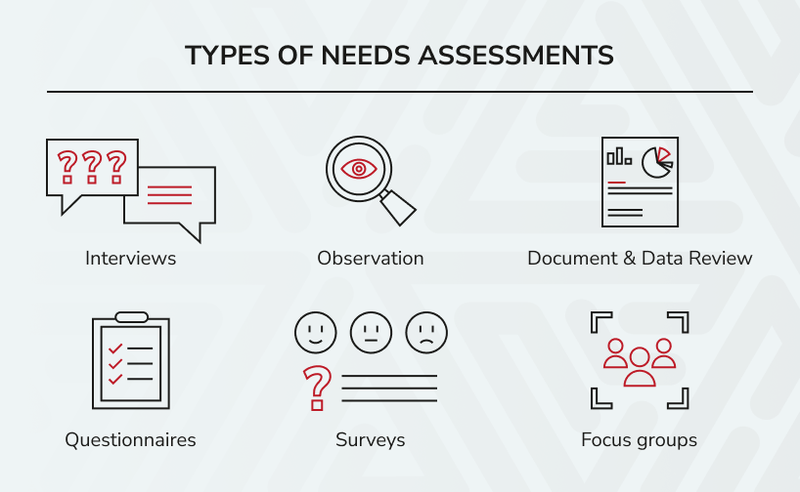At the outset of any project or phase, it is critical to identify which processes require improvement and to define the actions necessary to achieve the desired objectives. The deliverable is not a vague document but a short, structured brief that names the problem, outlines the business outcome, captures the gaps, and prioritizes the first actions.
To accomplish this, project managers conduct a Needs Assessment — a systematic process for diagnosing improvement opportunities and determining the organization’s requirements. Done right, this ensures clarity, alignment, and early risk reduction.
What is a Needs Assessment?
A Needs Assessment identifies the gaps between an organization’s current state and its desired state, then develops strategies to close them. Conducted during the Project Initiation phase, this process involves:
- Current & Desired State: Document where the organization stands today and where it needs to be.
- Gap & Root-Cause Hypotheses: Define the key discrepancies and what’s driving them.
- Priorities & Constraints: Decide which gaps matter most, considering time, budget, and strategic impact.
The key element is not volume but the right questions — targeted inquiries that reveal insights without drowning teams in data.
Needs Assessment Questions
Effective Needs Assessments hinge on asking focused, high-value questions:
- What problem are we solving? Get to the root business need. Ask for concrete examples — they often uncover new solution ideas. Consider the following:
- When did the problem occur?
- Who is involved?
- What caused the problem?
- What impact did does it have?
- What business outcome are we aiming for? Define success in business terms (cost reduction, cycle time, revenue, satisfaction). At this stage, determine what the organization understands by ‘success’, why it is important to achieve it, and what will happen if nothing changes.
- How will progress and success be measured? Establish KPIs and baselines, not just an endpoint.
- What has already been tried? Learn from past attempts — refine what worked, avoid repeating mistakes.
- What constraints exist? Capture non-negotiables: budget, timeline, compliance, or capacity.
- Who owns the outcome and who decides? Identify the sponsor and decision rights early.
- Who is impacted — and who can block this? Map stakeholders and their influence.
- What dependencies and risks exist? Surface issues that could derail progress.
- What data or evidence do we already have? Use reports, tickets, logs, or SLAs to ground findings.
- What are the first, smallest actions that move the needle? Define clear steps for 30–60–90 days.
- What will the course of action look like? Having gathered the core information, you move to the final report and action plan. Summarize the data and explain how everything will proceed, responsible members, resources needed, deadlines, milestones, etc.
Needs Assessment Methods

Data collection should match the project’s scale and context. Common methods include:
- Interviews: Targeted discussions with decision-makers and front-line staff.
- Observation/Shadowing: Watching how work actually happens to spot friction.
- Document & Data Review: Using existing reports, metrics, and logs.
- Surveys: Structured input from a wider group; useful for quantifying trends.
- Questionnaires: Quick pre-reads to standardize baseline inputs.
- Focus Groups: Moderated sessions for deeper insights into shared challenges.
Additional Tips to Remember
To make the assessment professional and efficient:
- Prepare core and follow-up questions in advance.
- Take structured notes — don’t rely on memory.
- Validate findings with data before recommending solutions.
Common Pitfalls to Avoid
- Jumping to solutions before the problem is clear.
- Collecting input without identifying a decision-maker.
- Treating opinions as facts with no baseline data.
- Designing plans without accounting for constraints.
Deliverable and Timeframe
A Needs Assessment does not always produce a fully defined solution. Its primary value is in providing clarity of the problem and direction of travel so that decision-makers can act with confidence. Depending on the project, the output may be:
- A problem definition that frames the issue clearly.
- A set of possible pathways or scenarios for further research.
- Early hypotheses on root causes that warrant deeper analysis.
- A prioritized set of next steps rather than a final action plan.
The format and timeframe vary with context. In some cases, an assessment can be wrapped up quickly to unblock a decision; in others, it may run longer to capture multiple perspectives and complexities. What matters is that the process gives leadership the insight needed to decide where to focus further effort and investment.
Bottom Line
Each Needs Assessment is tailored to its context, but the principles are constant: clarity, alignment, and action. By asking the right questions, collecting the right evidence, and delivering a concise plan, leaders reduce risk, avoid wasted spend, and set their initiatives up for measurable success.





